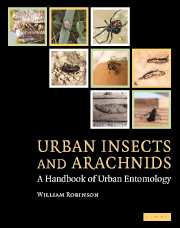Book contents
- Frontmatter
- Contents
- Preface
- Part I Urban entomology
- Part II Insects in the urban environment
- 4 Blattaria
- 5 Coleoptera
- 6 Collembola, Dermaptera
- 7 Diptera, Ephemeroptera
- 8 Hemiptera, Homoptera
- 9 Hymenoptera
- 10 Isoptera
- 11 Lepidoptera
- 12 Mantodea, Neuroptera
- 13 Orthoptera, Phasmatodea
- 14 Phthiraptera
- 15 Plecoptera, Psocoptera
- 16 Siphonaptera
- 17 Thysanoptera, Thysanura, Trichoptera
- Part III Other arthropods in the urban environment
- Family, genus, species index
- Index
- References
- Frontmatter
- Contents
- Preface
- Part I Urban entomology
- Part II Insects in the urban environment
- 4 Blattaria
- 5 Coleoptera
- 6 Collembola, Dermaptera
- 7 Diptera, Ephemeroptera
- 8 Hemiptera, Homoptera
- 9 Hymenoptera
- 10 Isoptera
- 11 Lepidoptera
- 12 Mantodea, Neuroptera
- 13 Orthoptera, Phasmatodea
- 14 Phthiraptera
- 15 Plecoptera, Psocoptera
- 16 Siphonaptera
- 17 Thysanoptera, Thysanura, Trichoptera
- Part III Other arthropods in the urban environment
- Family, genus, species index
- Index
- References
Summary
Introduction
Hymenoptera is a large order; the members occupy a large number of habitats. Ants, wasps, and bees have habits that range from solitary to species with complex social systems living in large colonies, and from plant-feeders to predators and parasites. Adults range from 0.2-mm-long parasites of insect eggs to 50-mm-long parasitic and predatory wasps. Antennae are long in social and parasitic species, with 13 segments in the male and 12 segments in the female, but may be as few as three segments. The mouthparts are mandibulate, but in many species there is also a tongue for lapping nectar from flowers. There are usually two pairs of wings, but many are wingless in one or both sexes or certain castes. They have complete metamorphosis, with egg, larva, pupa, and adult stages. The most advanced types of behavior and social structure are found in this order. The success of ants and the others that have evolved social behavior is based on nest building, colony housing, and a caste system. Some species control the sex of offspring by permitting or withholding fertilization; males are usually produced from unfertilized eggs, and females from fertilized eggs. Regulating the sex and size of individuals in large colonies is linked to a caste system and temporal and spatial partitioning of labor. For many species there are morphological adaptations and complex reproductive behaviors associated with socialization.
- Type
- Chapter
- Information
- Urban Insects and ArachnidsA Handbook of Urban Entomology, pp. 224 - 290Publisher: Cambridge University PressPrint publication year: 2005



